Analyzing Intel Core M Performance: How 5Y10 can beat 5Y71 & the OEMs' Dilemma
by Brett Howse & Ian Cutress on April 8, 2015 8:00 AM EST3DMark Cloud Gate Results
3DMark Cloud Gate is a benchmark aimed at notebooks and home PCs, and is quite a bit less demanding. It has a DirectX 11 engine but is limited to Direct3D feature level 10, and is compatible with DirectX 10 hardware. The overall run is about three minutes.
There is not much more to be said about the Core i5 at this point. It does an admirable job keeping the GPU frequency almost flat during this benchmark. You can clearly see the Dell Venue 11 Pro ramping up frequencies on the CPU, which cause temperature spikes when this happens. When it throttles the CPU on this workload, it does free up enough thermal room to allow the GPU frequency to be fairly strong. We see a lot of throttling on the ASUS as well, but not quite as pronounced. Once again, on the physics test the GPU is pushed down in frequency to give the CPU more room. The Yoga 3 Pro tries its best but is once again limited by a much lower SoC temperature set point.
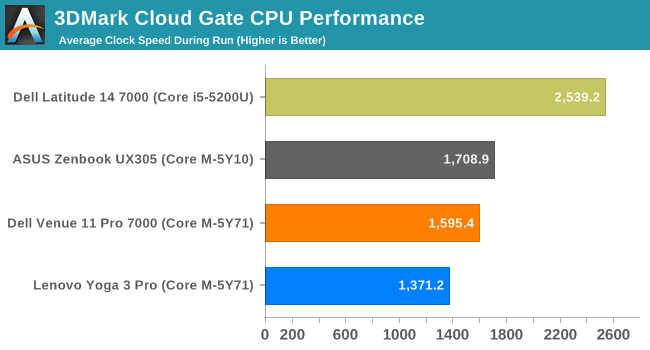
On the CPU side, we have a very similar situation to the Sky Diver benchmark. The ASUS once again keeps a higher average CPU frequency than all of the other Core M devices in this test. The Venue 11 is close though.
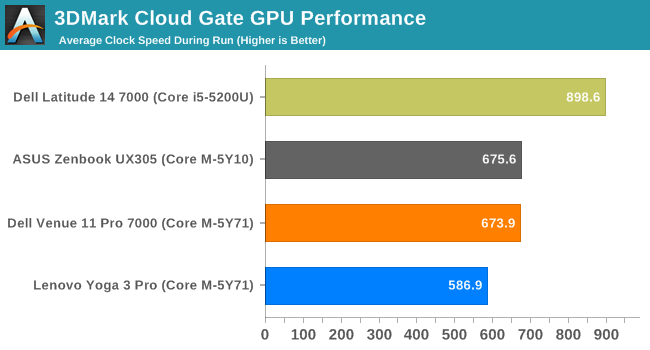
On the GPU side, the Zenbook and Venue 11 Pro are basically tied. The shorter and less demanding workload lets the Dell keep up despite not having as good of a cooling solution. But, averages are just averages. Clearly the ASUS keeps a substantially higher GPU frequency for much of this test, as is seen in the graph.

The SoC temperatures are actually quite high on the Zenbook in this test, with it coming close to the Venue 11 Pro, but the cooling system clearly is more efficient since the change in temperature on the ASUS is much more gradual than the spikes seen in the Venue 11 Pro. The Yoga 3 Pro tries to stay around 65°C but near the end the temperature does go above their target.
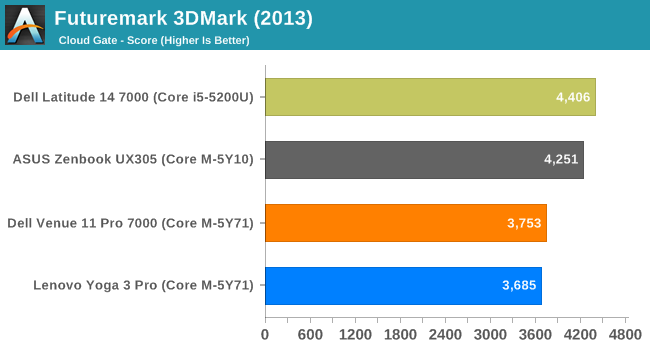
The overall benchmark results for this test are very similar to the previous 3DMark test. The ASUS comes in very close to the Dell Latitude with its Core i5, and the other devices fall back quite a ways. Long sustained GPU workloads are very difficult for both of the 5Y71 devices to handle.


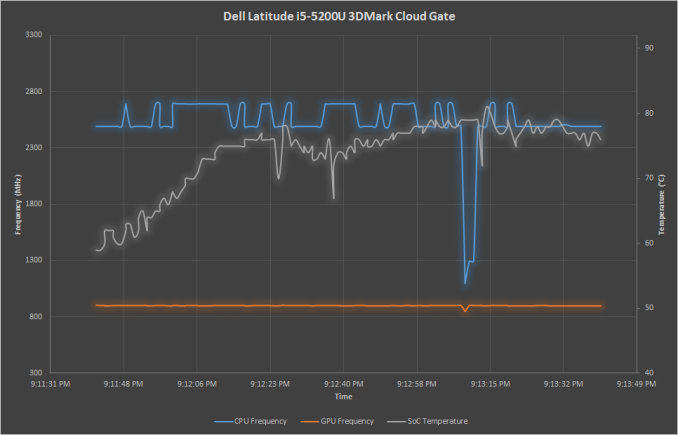
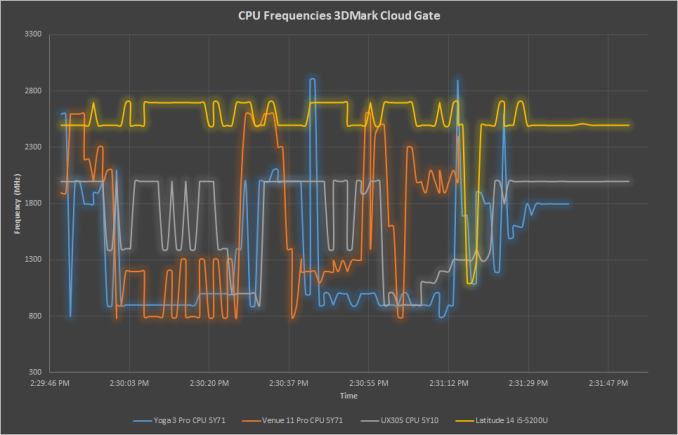
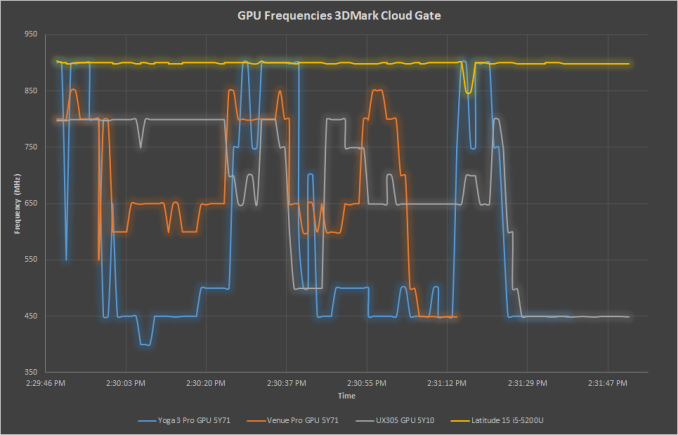
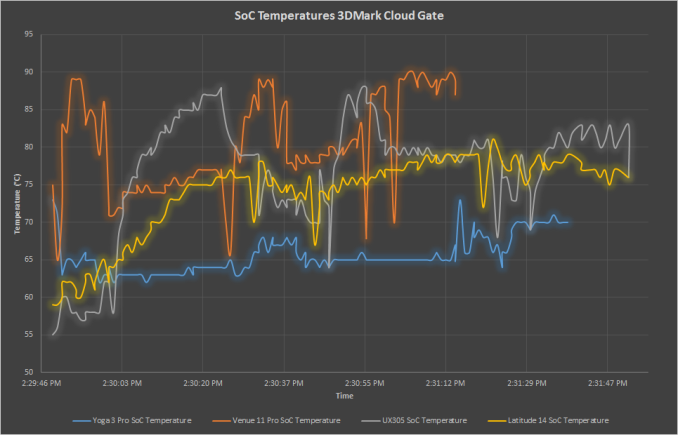








110 Comments
View All Comments
serendip - Wednesday, April 8, 2015 - link
Core M is expensive for what it does. If you want mobility without a fan, go with Atom. If you want better unthrottled performance, go with the U models.It's the weird throttling and poor OEM thermal designs which concern me. Core M may have good turbo speeds but that's useless if it has to throttle down quickly from heat soak. Users will be disappointed when their machines act speedy one moment and start lagging the next, no matter what the design turbo speeds are.
serendip - Wednesday, April 8, 2015 - link
Can't edit comments, sigh. Anyway, my Bay Trail Atom tablet runs from 600 MHz to 1.86 GHz and has no issues with thermal throttling. It can smoothly turbo and then clock down without dropping down too far and sacrificing usability.It seems some OEMs like Lenovo set a total system power draw limit that's too low, on top of skin thermal limits. The CPU can only turbo for very short periods of time before being dropped to base speed or even lower. You're then stuck with a 1 GHz CPU and 100 MHz GPU which you paid a ton of money for. I think the problem lies with both sloppy engineering from OEMs and unrealistic promises made by Intel.
nonoverclock - Wednesday, April 8, 2015 - link
I have a Bay Trail Atom (Venue Pro 11) and it's alright but I definitely need more speed. Trying to stream sports games through their Metro apps will often skip and this doesn't happen on my higher performance devices. Also it has some inexplicable pauses here and there. More speed would be great.Brett Howse - Wednesday, April 8, 2015 - link
I think you are missing the fact that even throttled Broadwell is a lot faster than Silvermont cores. I don't have the T100 in the notebook bench (it is a tablet) but the HP Stream has two Silvermont cores and a 7.5 watt TDP http://anandtech.com/bench/product/1449?vs=1400If you want to compare to quad-core Bay Trail some of the scores are here http://anandtech.com/show/7428/asus-transformer-bo...
Bay Trail was a big boost for Atom but I would take Core M in a mobile device over it any day.
Pissedoffyouth - Thursday, April 9, 2015 - link
My bay trail Asus T100 never throttles back from 1.8ghz even under prime95+furmark. very power efficientsonicmerlin - Wednesday, April 8, 2015 - link
I really like this article, but I wish you had run GFXBench, which is more of a pure GPU test. I want to compare the results to the iPad's A8X and Tegra K1.Brett Howse - Wednesday, April 8, 2015 - link
I have discussed this in the actual device reviews. This article wasn't about that kind of comparison so I will ask you to go to the review http://anandtech.com/show/9104/asus-zenbook-ux305-...testbug00 - Wednesday, April 8, 2015 - link
All this testing, and, I don't see a single power system power draw number for anything. Maybe I'm missing something? But, woudn't seeing the i5 system draw 7-13 watts more be useful for determining how good Core M is?If the product uses a third of the power and gets 50-100% of the performance... Well. That's very impressive.
Alexvrb - Wednesday, April 8, 2015 - link
Do you like phystics? Do you like phystics in your mouth? (typo on page 2!)Brett Howse - Thursday, April 9, 2015 - link
TYVM :)